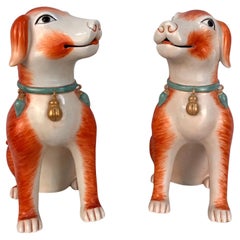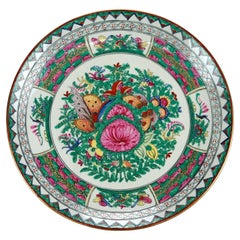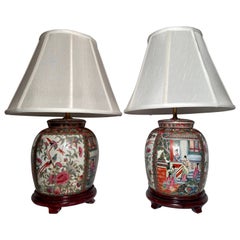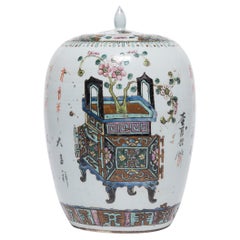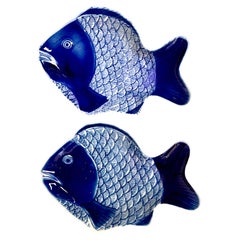Early 20th Century Ceramics
3
342
to
62
342
111
342
342
342
6
2
1
1
1
1
1
322
587
941
169
342
254
93
31
5
20
18
7
16
19
11
8
5
335
185
17
16
13
324
299
196
100
4
16
7
4
3
2
Item Ships From: USA
Period: Early 20th Century
Famille Verte Porcelain Cabbage Leaf & Butterfly Coffee or Tea Cup and Saucer
Located in New York, NY
A very beautiful and rare porcelain Famille Verte cabbage leaf and butterfly pattern coffee or tea cup and saucer set, circa e...
Category
Chinese Chinese Export Early 20th Century Ceramics
Materials
Porcelain
Large Pair Chinese Export Style Sated Dogs
Located in Bradenton, FL
Large pair of Chinese Export style seated dogs. A true pair one facing the right, the other to the left. Exquisitely modeled and painted, with blue and gold gilt...
Category
Chinese Chinese Export Early 20th Century Ceramics
Materials
Porcelain
Antique Chinese Rose Medallion Porcelain Charger, circa 1920
Located in Big Flats, NY
An antique Chinese Rose Medallion charger offers porcelain construction with garden scenes having butterflies and flowers, en verso signed as ph...
Category
Chinese Early 20th Century Ceramics
Materials
Porcelain
Pair Antique Chinese Famille Rose Porcelain Lamps, circa 1900-1920
Located in New Orleans, LA
Pair Antique Chinese Famille Rose Porcelain Lamps, Circa 1900-1920.
Category
Chinese Early 20th Century Ceramics
Materials
Porcelain
Chinese Famille Rose Ginger Jar with Ancient Censers, c. 1900
Located in Chicago, IL
Beautifully commemorated on this oval ginger jar, censers have been used for thousands of years in Chinese culture as a part of funeral rites or prayer offerings. Filled with dried a...
Category
Chinese Chinese Export Early 20th Century Ceramics
Materials
Porcelain
Meiji Period Fukagawa Blue & White Fish Plates, 2 Available
By Fukagawa
Located in West Palm Beach, FL
Meiji Period Fukagawa blue & white fish plates, 2 available
Japan Circa 1900s
Offering two similar Fukagawa (Attributed) realistically decorated by hand-painting and cobalt blue enamel. With decorated backs, Unmarked.
Sold individually. Please let us know if you would like to purchase the top fish plate or the lower plate.
The lower plate has some firing marks on the fishes face...
Category
Japanese Meiji Early 20th Century Ceramics
Materials
Porcelain
Pair Chinese Export Famille Rose Enameled Elephant Candle Holders, Early 20th C
Located in Austin, TX
A delightful pair of Chinese export famille rose enameled porcelain candle holders, late Qing Dynasty or early Republic Period, early 20th century, China.
The whimsical pair of ca...
Category
Chinese Chinese Export Early 20th Century Ceramics
Materials
Porcelain
Early 20th Century Pair of Small Japanese Kutani Porcelain Damascene Vases
Located in North Miami, FL
Early 20th century pair of small Japanese Kutani Porcelain Damascene vases. They are black, matte ground, and hand painted gold tone scenes of bamboo. These are signed in characters ...
Category
Japanese Early 20th Century Ceramics
Materials
Gold Leaf
Shoji Hamada Japanese Earth-Toned Glazed Vase with Original Signed Sealed Box
By Shoji Hamada
Located in Studio City, CA
An exquisite, beautiful flower vase by master Japanese potter Shoji Hamada featuring an example of his popular two-color, sumptuous earth-toned ...
Category
Japanese Showa Early 20th Century Ceramics
Materials
Stoneware
Japanese Ceramic Centerpiece Bowl Makuzu Kozan Meiji Period
By Makuzu Kozan
Located in Atlanta, GA
A beautiful ceramic vessel in the form of Bo, the so-called monk's alms bowl from the studio of Japanese Potter Makuzu Kozan, also known as Miyagawa Kozan (1842–1916), one of the most established and collected ceramist from Meiji Period. Born as Miyagawa Toranosuke, Kozan established his pottery studio in Yokohama circa 1870s and later became one of the appointed artists to the Japanese Imperial household. His work was exhibited in many international fairs that the Meiji government participated at the turn of the century and won many grand prizes.
Of a relatively large size, this piece was made as a decorative center piece for display. It was brilliantly decorated with underglaze paint of a green-on-green bamboo motif, using the novel technique developed by Kozan called Fuki-e (the blow painting). As a result, the bamboos appear took on a three-dimensional quality as if appearing in a mist. Known as one of the most creative ceramists, circa 1887, Kozan started experimenting with new chemical colors from the West in the format of his porcelain glaze. New colors allowed him to create underglaze design that appeared bright, smooth and glossy. To create design that is realistic and dimensional, more common in the western paintings, he was inspired by the native Japanese ink painting technique developed around 1900 by Yokoyama Taikan...
Category
Japanese Japonisme Antique Early 20th Century Ceramics
Materials
Ceramic
Pair of Chinese Export Blue and White Pear Shaped Porcelain Lidded Vases
Located in Atlanta, GA
A pair of blue and white Chinese export porcelain vases from the early 20th century, with lids and Chinoiseries scenes. Cr...
Category
Chinese Chinese Export Early 20th Century Ceramics
Materials
Porcelain
Chinese Squared Famille Rose Ginger Jar with Ritual Vessels, c. 1900
Located in Chicago, IL
Beautifully commemorated on this squared ginger jar, tripod censers and bronze ritual vessels have been used for thousands of years in Chinese cultur...
Category
Chinese Chinese Export Early 20th Century Ceramics
Materials
Porcelain
Japanese Satsuma Vase
Located in Douglas Manor, NY
Japanese Satsuma hand decorated vase.
Category
Japanese Vintage Early 20th Century Ceramics
Materials
Ceramic
Chinese Early 20th C. Glazed Porcelain Roof Tile of a Warrior Riding a Monkey
Located in New York, NY
Chinese glazed porcelain roof tile of a warrior riding a monkey. The manufacture of glazed tiles was standardized in the Ming Dynasty and during the Qing Dynasty into the Republican Era, glazed tiles became ever more popular for top-tier buildings, including palace halls in the Forbidden City and ceremonial temples like the Heavenly Temple. The piece is signed and mounted on a presentation display stand.
The monkey is the ninth of the 12-year cycle of animals which appear in the Chinese zodiac related to the Chinese calendar. The Year of the Monkey...
Category
Chinese Early 20th Century Ceramics
Materials
Ceramic
Japanese Blue and White Sake Cask
Located in Chicago, IL
This large porcelain jar is a vintage Japanese sake keg dated to the early 20th century. Known as taru or daru, large sake casks such as this are often saved...
Category
Japanese Early 20th Century Ceramics
Materials
Iron
Antique Chinese Foo Dog Candle Holder
Located in Dallas, TX
An antique Chinese Foo Dog with silver inlaid wood stand. Circa 1900 very fine detail.
Category
Chinese Antique Early 20th Century Ceramics
Materials
Ceramic, Wood
20th Century Antique Chinese Qing Era Porcelain Foo Dogs
Located in Pomona, CA
This pair of magnificent Chinese antique Porcelain lions/foo dogs statuary are hand made and hand carved porcelain. According to historical ...
Category
Chinese Chinese Export Early 20th Century Ceramics
Materials
Porcelain
Chinese Famille Rose Bowl with Pheasant and Chrysanthemums, c. 1900
Located in Chicago, IL
During the 18th century, Europeans provided an eager market for Chinese export porcelain, especially the colorful and fanciful ware known as “famille rose.” Named for a palette of op...
Category
Chinese Chinese Export Early 20th Century Ceramics
Materials
Porcelain
Chinese Pair of Famille Rose Porcelain Doves 'Birds', Ric.00035
Located in Norton, MA
Pair of porcelain doves. China. early 20th century. Famille rose glaze. Measure: 7.25in high.
Category
Chinese Qing Early 20th Century Ceramics
Materials
Porcelain
Japanese Kutani Treasure Boat 'Takarabune' Censer, Taisho Period, Japan
Located in Austin, TX
A wonderful Japanese Kutani porcelain incense burner, koro, in the form of a treasure ship, Takarabune, Taisho Period (1912 - 1926), Japan.
The censer boldly modeled as the legendary Takarabune, or Treasure Ship, a mythical ship said to carry the shichifukujin, the Seven Lucky Gods, around the heavens during the first days of the New Year, visiting lucky humans to bring blessings and prosperity.
The black bodied, single mast ship sails on the water, its sail full of wind and decorated with the character "takara", meaning treasure. The pierced top of the ship serving as the cover for the censer. It is loaded with magical items and treasure, most prominently, a large coral branch...
Category
Vintage Early 20th Century Ceramics
Materials
Porcelain
Japanese Meiji Period Early 20th Century Sake Bottle with Brown Patina
Located in Yonkers, NY
An antique Japanese Meiji period monochrome sake bottle from the early 20th century with concentric lines. Created in Japan during the Meiji dynasty, this sake bottle attracts our at...
Category
Japanese Meiji Early 20th Century Ceramics
Materials
Ceramic
Collection of Four Japanese Tamba Tokkuri Sake Bottles
Located in Atlanta, GA
A set of four Japanese Ceramic Tokkuri Sake storage bottles circa early 20th century (Meiji to Taisho period). The bottles were made in Tamba (Tanba) kil...
Category
Japanese Japonisme Early 20th Century Ceramics
Materials
Ceramic
Japan Antique Set Three Brilliant Color Hand Painted Garden Bowls, 1910
Located in South Burlington, VT
From our recent Japanese Acquisition Travels- matching set three (3) three gorgeous hand painted bowls from Japan in their original tomobako box.
Japan hard to find early set of th...
Category
Japanese Taisho Early 20th Century Ceramics
Materials
Ceramic
Japanese Glazed Ceramic and Silver Koro Incense Burner Makuzu Kozan
By Makuzu Kozan
Located in Atlanta, GA
A tri-pod ceramic incense burner (koro) by Japanese Imperial potter Makuzu Kozan (1842-1916) circa late Meiji to the start of Taisho period (1890-1910s). A fine example of the artist's work belonging to the late part of his underglaze paint phase (started around 1887 until his death), the surface of the koro was painted in beautiful shades of blue to depict a continuous landscape not unlike a traditional ink and watercolor hand scroll. The rise and fall mountains recede and fade into the horizon and are dotted with groves of pines. The sky is painted with a beautiful subtle shade of pink, suggesting a time of sunrise or sunset. The koro is fitted with an ensuite reticulated sterling silver hoya (incense cover), pierced with swirling cloud and marked with "pure silver' in Kanji. The base is signed in underglaze blue "Makuzu Kozan Sei" within a double ring. The piece is beautifully potted in form and the decoration was done with expertise using the novel technique developed by Kozan called Fuki-e (the blow painting), in order to achieve the striking landscape known as "Mountain and Water" with sense of dimensions and gradient, the poetic effects normally conveyed only by sumi ink staining on paper. The piece comes with an unsigned tomobako (wood storage box) of a recent age.
Also known as Miyagawa Kozan (1842–1916), Makuzu Kozan was one of the most established and collected ceramist from Meiji Period. Born as Miyagawa Toranosuke, Kozan established his pottery studio in Yokohama around 1870s and later became one of the appointed artists to the Japanese Imperial household. His work was exhibited in many international fairs that the Meiji government participated at the turn of the century and won many grand prizes. Being one of the most creative ceramists, Kozan started experimenting with new chemical colors from the West in the format of his porcelain glaze around 1880s. New colors allowed him to create underglaze designs that appeared bright, smooth and glossy. He even invented his own receipt of cobalt blue to achieve a much brighter yet softer shade, as evident on this vase. To create landscape that is realistic and dimensional, more common in the western paintings, he was inspired by the native Japanese ink painting technique developed around 1900 by Yokoyama...
Category
Japanese Japonisme Antique Early 20th Century Ceramics
Materials
Silver
Pair Chinese Dragon Fish Glazed Porcelain Vase, Qing Dynasty, 19th-20th Century
Located in Austin, TX
A fantastic pair of Chinese molded and glazed biscuit porcelain vases with leaping dragon fish or makara, late Qing dynasty, circa 1900.
The vases of balu...
Category
Chinese Qing Antique Early 20th Century Ceramics
Materials
Porcelain
Japanese Pair Hand Decorated Satsuma Lidded Cups
Located in Douglas Manor, NY
Pair Japanese Satsuma hand decorated lidded cups
Measures: 3.25" x 4.25"
3.5" x 4.5"
Signed on bottom.
Category
Japanese Vintage Early 20th Century Ceramics
Materials
Ceramic
Chinese Ceramic Spotted Cat Headrest, c. 1900
Located in Chicago, IL
To keep her elaborate hairstyle intact while sleeping, a well-to-do Qing-dynasty woman once used this ceramic headrest as a pillow. The headrest is shaped as a crouching house cat, w...
Category
Chinese Qing Early 20th Century Ceramics
Materials
Ceramic
Korean Ceramic Water Dropper in Frog Form
Located in Atlanta, GA
A Korean ceramic water dropper in the form of fog circa early 20th century likely from Japanese colonial time post 1910s. The animal form features under...
Category
Early 20th Century Ceramics
Materials
Ceramic
Middle Eastern Ceramic Mosque Lamp
Located in New York, NY
Very fine quality Middle Eastern blue and white ceramic Mosque lamp with original hardware chains.
Category
Asian Antique Early 20th Century Ceramics
Materials
Pottery
Antique Japanese Porcelain Brazier 'Incense Burner', Signed
Located in Norton, MA
A very unusual Antique Japanese Porcelain Brazier (Incense Burner) with green checker pattern, Signed on the bottom.
Category
Japanese Early 20th Century Ceramics
Materials
Porcelain
Kichizaemon Raku Seinyu XIII "13th" Signed Antique Japanese Raku Chawan Tea Bowl
Located in Studio City, CA
A wonderfully glazed, impeccably made Chawan tea bowl by famed Japanese master potter the 13th Kichizaemon Raku, Seinyu (1887-1944) who was the eldest son of Konyu - the 12th Kichizaemon of the Raku family line of potters - known as the most noted and celebrated tradition of pottery within the world of Japanese tea. Kichizaemon Raku was the 13th master to carry on the family's esteemed name and tradition. The bowl features shifting textures and deep, rich colours which radiate in the light.
The term "Raku" was derived from the site where clay was dug in Kyoto in the late 16th century. The Kanji character for Raku translates to "enjoyment" or "fun/delightful" For 15 generations it has been the title and seal used by a lineage of potters whose work formed the central tradition in Japan. This lineage believes that 'Raku' refers to the potters who use the technique, not the technique itself. In the 16th century, the first of these potters, Chojiro is said to have come under the patronage of the Japanese tea master, Sen-No-Rikyu. According to legend, in 1598 a few years after Chojiro's death, ruler, Hideyoshi Toyotomi bestowed upon his adopted son, Jokei, a golden seal with the written symbol "Raku." Both the name and the ceramic style have been passed down through the family to the present ever since. The name and the style of ware have become influential in both Japanese culture and literature. Raku ware marked an important point in the historical development of Japanese ceramics, as it was the first ware to use a seal mark and the first to focus on close collaboration between potter and patron. Other famous Japanese clay artists...
Category
Japanese Meiji Early 20th Century Ceramics
Materials
Ceramic
Boch Freres Chinoiserie Porcelain Gilt Floral Ginger Jar Hand Painted Table Lamp
Located in Brooklyn, NY
Boch Freres Chinoiserie Porcelain Gilt Floral Ginger Jar Hand Painted Table Lamp. Gorgeous and monumental gilt hand painted floral porcelain chinoiserie ginger jar wired as lamp. Lovely scale and proportions. Genius use of color. Victorian lampshade...
Category
Belgian Hollywood Regency Early 20th Century Ceramics
Materials
Porcelain
Antique Chinese Canton Porcelain Square Tea Jar Lamp, Circa 1900-1920
Located in New Orleans, LA
Antique Chinese canton porcelain square tea jar lamp, Circa 1900-1920.
Category
Chinese Early 20th Century Ceramics
Materials
Porcelain
Chinese Export Kendi, Swatow Ware, Porcelain with Polychrome Enamels, circa 1900
Located in Austin, TX
A delightful Swatow ware Chinese export shipwreck porcelain kendi featuring a writing dragon and an apocryphal Tongzhi mark, late 19th or early 20th centur...
Category
Chinese Qing Antique Early 20th Century Ceramics
Materials
Porcelain
Japanese Porcelain Glazed Vase with Dragon Design Mazuku Kozan
By Makuzu Kozan
Located in Atlanta, GA
A porcelain vase with dragon design by Japanese imperial potter Makuzu Kozan (1842-1916), circa 1900s. The vase is made in what is considered early phase of his underglaze period during late Meiji era. In a classic baluster form, the surface of the vase was decorated with a slithering dragon in underglaze iron red circulating the exterior among pink clouds. The animated rendering of the dragon is fine and detailed, with five claws, scales, long tails and highlighted eyes. The pink cloud is misty and called Morotai or the hazy style, created with a unique technique developed in Kozan's studio called fuki-e by blowing the pigment powders onto the surface. Kozan Studio experimented with newly available colors from the west starting in the 1880s, which resulted in the expansion of the palette and style that bridged the east and west aesthetic tradition. Marked in underglaze blue on the base.
Known also as Miyagawa Kozan...
Category
Japanese Japonisme Antique Early 20th Century Ceramics
Materials
Porcelain
Japanese Seto Porcelain Vegetable Bowl with Hand-Painted Blue and White Décor
Located in Yonkers, NY
An antique Japanese blue and white hand-painted porcelain Seto ware vegetable bowl from the early 20th century, with landscape and calligraphy décor. Produced in one of the six ancient kilns of Japan, this porcelain vegetable bowl features a circular lid adorned with landscape, architecture and calligraphy motifs, sitting above a circular tapering body echoing the motifs from the top. Its blue and white hand-painted décor and simple lines will make this Japanese Seto porcelain...
Category
Japanese Early 20th Century Ceramics
Materials
Porcelain
Korean Carved Celadon Vase, Maebyeong, Goryeo Style, Early 20th Century
Located in Austin, TX
A wonderful Korean celadon vase, called a maebyeong, in the Goryeo style, but of early 20th century manufacture.
The maebyeong vase with a beaut...
Category
Korean Early 20th Century Ceramics
Materials
Stoneware
Chinese Republic Period Famille Noire Porcelain Plaque Painted with Parrots
Located in West Palm Beach, FL
Chinese Republic Period Famille Noire porcelain plaque painted with parrots signed with oblong iron red seal, in a later hardwood and ebonized frame
Measures: Plaque 9"x 12"
Frame 14...
Category
Chinese Chinese Export Early 20th Century Ceramics
Materials
Brass
Pair of Petite Chinese Famille Rose Longevity Vases, c. 1900
Located in Chicago, IL
Unusual for the petite size, this pair of vases is a beautiful example of famille rose enamelware, also known as fencai ware, meaning "powdery color." Manufactured in the Qing court’s imperial workshops, this technique of overglazing porcelain with enamel gets its name from the white, opaque enamels used to create color gradients and a soft, pastel effect.
Each vase depicts a meeting of Shoulao, the God of Longevity...
Category
Chinese Chinese Export Early 20th Century Ceramics
Materials
Porcelain
Chinese Famille Verte Hat Stand with Ancient Censers, c. 1900
Located in Chicago, IL
Dated to the late 19th century, this porcelain hat stand was once used by a Qing-dynasty gentleman to display his cap while it wasn't being worn. The hat stand is decorated in the fa...
Category
Chinese Chinese Export Early 20th Century Ceramics
Materials
Porcelain
Chinese Blanc-de-Chine Seated Guanyin Altar Piece, 19th/20th Century
Located in West Palm Beach, FL
Chinese Blanc-de-Chine Seated Guanyin Altar Piece , 19th/20th Century
A large and impressive work, in two parts bearing seal/reign mark on the back o...
Category
Chinese Chinese Export Early 20th Century Ceramics
Materials
Porcelain
Chinese Gilt Green Glazed Teapot, c. 1900
Located in Chicago, IL
Tea drinking has been an integral part of Chinese culture for centuries, resulting in a wide range of social customs and material traditions. In addition to tea leaves, water, and he...
Category
Chinese Chinese Export Early 20th Century Ceramics
Materials
Porcelain
Large Chinese Antique Jar with Mustard Glaze, Bird and Floral Motifs, circa 1900
Located in Yonkers, NY
A large Chinese antique jar from the turn of the century, with mustard glaze and floral and bird motifs. Born in China in the early years of the 20...
Category
Chinese Early 20th Century Ceramics
Materials
Ceramic
Large Antique Early 20th Century Vietnamese Blue Martaban Jar with Raised Motifs
Located in Yonkers, NY
An antique Vietnamese large blue Martaban jar from the early 20th century, with raised motifs. Created during the early 20th century, this large bue Marta...
Category
Vietnamese Early 20th Century Ceramics
Materials
Ceramic
Chinese Persimmon Phoenix Tail Vase with Cartouche Paintings, c. 1920s
Located in Chicago, IL
This vase is a perfect example of enduring Chinese symbolism and design. The attendants in the garden are watching over young boys playing with lotus branches, butterflies and small ...
Category
Chinese Art Deco Early 20th Century Ceramics
Materials
Porcelain
Early 20th Large Century Kutani Porcelain Vase
Located in Lambertville, NJ
Elegant hand painted Japanese porcelain Kutani Vase, 25.5 inches tall with delicate and crisp hand painted Japanese scenes with the classic iron red accent color. The front cartouche...
Category
Japanese Early 20th Century Ceramics
Materials
Porcelain
Japanese Satsuma Ceramic Ewer Yabu Meizan
By Yabu Meizan
Located in Atlanta, GA
A Satsuma ware miniature ewer from the studio of Yabu Meizan (birth name Yabu Masashichi; 1853-1934), who was one of the most celebrated and collectible Satsuma artists from the Meij...
Category
Japanese Japonisme Early 20th Century Ceramics
Materials
Ceramic
Pair of Rare Porcelain Commemorative Vases by Makuzu Kozan Meiji Period
By Makuzu Kozan
Located in Atlanta, GA
A pair of porcelain vases in classic form, decorated with underglaze blue and copper red painting by Imperial potter Makuzu Kozan. Also known as Miyagawa Kozan (1842–1916), Makuzu was one of the most established and collected ceramist known to the west from Meiji Period.
The vases are in a classic Chinese form called "Bang Chu Ping" (grain-mallet vase...
Category
Japanese Japonisme Vintage Early 20th Century Ceramics
Materials
Ceramic
Chinese Blue and White Plate, c. 1900
Located in Chicago, IL
An everyday example of Chinese blue-and-white porcelain, this petite footed dish charms with expressive sweeps of blue atop a blue-grey underglaze. Once used for serving food and dri...
Category
Chinese Qing Early 20th Century Ceramics
Materials
Ceramic
Chinese Export Porcelain Rose Medallion Vase, Canton, circa 1900
Located in Banner Elk, NC
Chinese export porcelain rose medallion vase, 23in, Canton, circa 1900.
Category
Chinese Chinese Export Antique Early 20th Century Ceramics
Materials
Porcelain
Early 20th Century Porcelain Maneki Neko, Japan
Located in Point Richmond, CA
Early 20th century porcelain Maneki Neko, Japan
This porcelain Maneki Neko, the good fortune beckoning cat, is a molded seated form with the right raised ...
Category
Japanese Folk Art Early 20th Century Ceramics
Materials
Porcelain
Chinese Blue and White Plate, c. 1900
Located in Chicago, IL
An everyday example of Chinese blue-and-white porcelain, this petite footed dish charms with expressive sweeps of blue atop a blue-grey underglaze. The tapered sides are loosely brus...
Category
Chinese Qing Early 20th Century Ceramics
Materials
Ceramic
Antique Japanese Porcelain Figural Owl Wall Pocket Vase Meiji Period
Located in San Diego, CA
We are offering a beautiful Japanese porcelain figural owl wall pocket vase dating from the Meiji Period. Great details and form. This would have moun...
Category
Japanese Early 20th Century Ceramics
Materials
Porcelain
Chinoiserie Ceramic Famille Rose Oval Platter in Pink and Gold Floral Motif
Located in Oklahoma City, OK
A gorgeous oval Famille rose chinoiserie platter. This beautiful ceramic piece is oval in form, and features a hand painted floral motif desig...
Category
Chinese Chinoiserie Early 20th Century Ceramics
Materials
Ceramic, Paint
Japanese Porcelain Vase Makuzu Kozan Meiji Period
By Makuzu Kozan
Located in Atlanta, GA
A striking blue and white vase from the studio of Japanese Potter Makuzu Kozan, also known as Miyagawa Kozan (1842–1916), one of the most established and collected ceramist from Meiji Period. Born as Miyagawa Toranosuke, Kozan established his pottery studio in Yokohama circa 1870s and later became one of the appointed artists to the Japanese Imperial household. His work was exhibited in many international fairs that the Meiji government participated at the turn of the century and won many grand prizes.
Of a relatively large size, this vase is decorated with underglaze cobalt blue using the novel technique developed by Kozan called Fuki-e (the blow painting). As a result, the bamboos appear took on a three-dimensional quality as if appearing in a mist. Known as one of the most creative ceramists, circa 1887, Kozan started experimenting with new chemical colors from the West in the format of his porcelain glaze. New colors allowed him to create underglaze design that appeared bright, smooth and glossy. He even invented his own receipt of cobalt blue to achieve a much brighter yet softer shade, as evident on this vase. To create landscape that is realistic and dimensional, more common in the western paintings, he was inspired by the native Japanese ink painting technique developed around 1900 by Yokoyama Taikan...
Category
Japanese Japonisme Antique Early 20th Century Ceramics
Materials
Ceramic
Chinese Celadon and Tonal Pattern Porcelain Pot
Located in New York, NY
Chinese celadon, porcelain pot decorated with a raised, tonal botanical and dragon design wrapping the entirety of its bulbous form and accented with foo...
Category
Chinese Chinese Export Early 20th Century Ceramics
Materials
Porcelain
Large Early 20th Century Tianqiuping or Globular Cloisonné Vase
Located in Miami, FL
Large early 20th century tianqiuping or globular cloisonné vase. Highest quality enamel cloisonné, withe background with graphic scenes and floral pattern and with three large frame ...
Category
Chinese Ming Early 20th Century Ceramics
Materials
Ceramic
Japanese Ceramic Form of a Human Skull with a Snake
Located in Hudson, NY
Seal on bottom reads: Koun.
Category
Japanese Early 20th Century Ceramics
Materials
Ceramic
Recently Viewed
View AllMore Ways To Browse
Asian Antique Blue And White Vases
Dynasty Plate
Asian Brown Jars
Asian Blue Vases With Flowers
Kangxi Period
Chinese Celadon Porcelain
Hand Painted Vase Asian Blue
Famille Verte Porcelain
Qianlong Period
Antique Chinese Seal
Underglaze Blue Japanese Porcelain
Antique Chinese Seals
Green Asian Pottery
Porcelain Japanese 1900
Ming Green
Qing Qianlong
Asian Ginger Jar
Asian Ginger Jars

